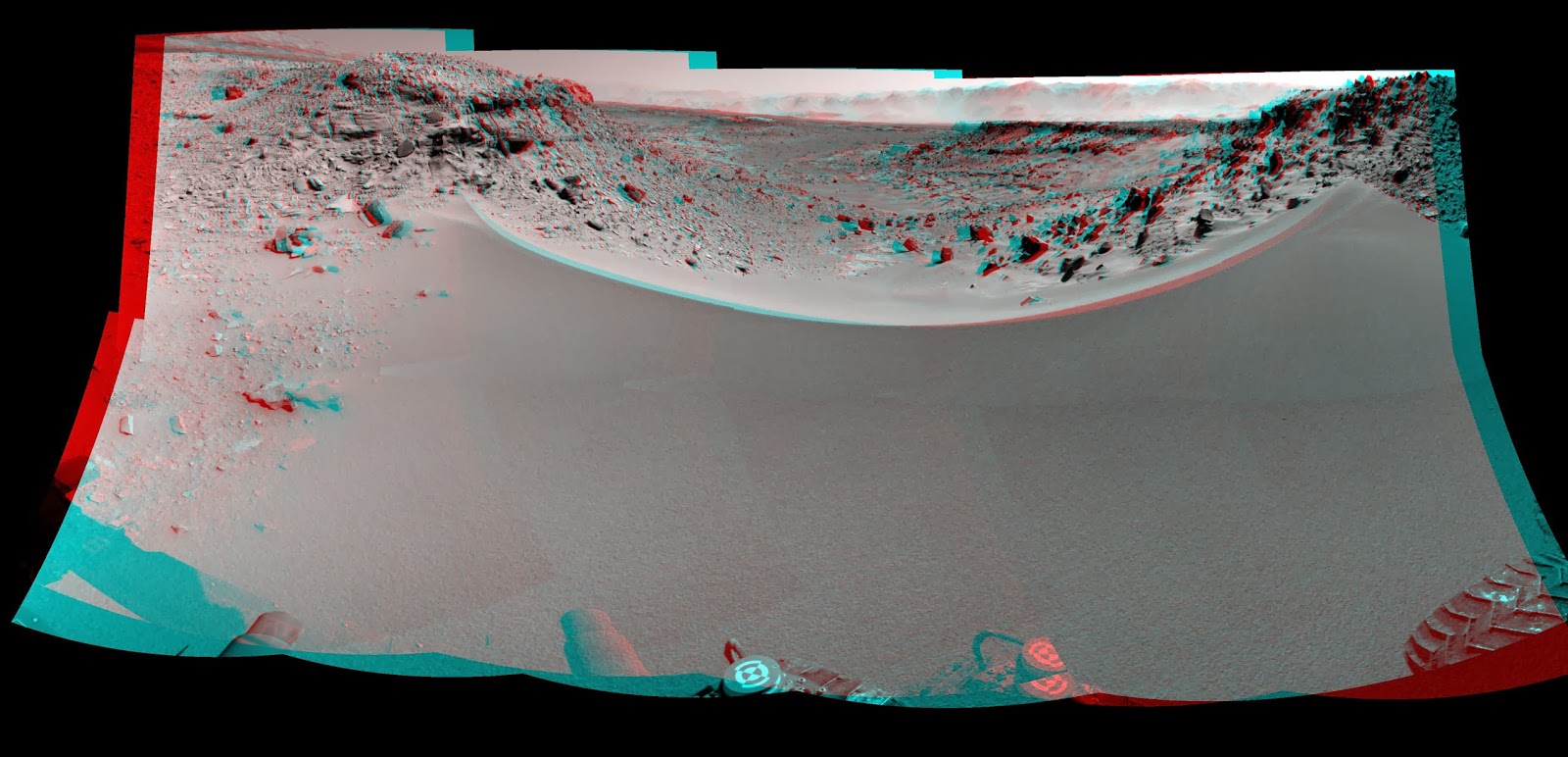NASA's Curiosity Mars rover caught its own shadow in this image taken just after completing a backward drive of 329 feet (100.3 meters) on the 547th Martian day, or sol, of the rover's work on Mars (Feb. 18, 2014). NASA/JPL-Caltech
The 1-ton Curiosity rover covered 329 feet (100 meters) in reverse on Tuesday (Feb. 18). The maneuver — carried out over relatively smooth and benign ground — was designed to test out a strategy for reducing wear on the robot's six metal wheels, which have accumulated dings and holes at an increasing rate over the last few months, NASA officials said."We wanted to have backwards driving in our validated toolkit because there will be parts of our route that will be more challenging," Curiosity project manager Jim Erickson, of NASA's Jet Propulsion Laboratory in Pasadena, Calif., said in a statement.
Friday, February 21, 2014
Tuesday, February 11, 2014
"The Martian" by Andy Weir... "For the record, I didn't die on Sol-6... I might be the first human being to die on Mars...."
He got the idea for "The Martian" in 2009, and spent three years working out the details of the story. He drew on a real NASA proposal for a Mars mission called Mars Direct, which involves sending supplies in unmanned ships to Mars ahead of the crew, then sending astronauts in a lighter, faster ship. He'd been rebuffed by literary agents in the past, so he decided to put the novel on his website free of charge rather than to try to get it published. A few fans asked him to sell the story on Amazon so that they could download it to e-readers. Mr. Weir had been giving his work away, but he began charging a modest amount because Amazon set the minimum price at 99 cents. He published the novel as a serial on the site in September 2012. It rose to the top of Amazon's list of best-selling science-fiction titles. He sold 35,000 copies in three months. Agents and publishers and movie studios started circling. Mr. Weir signed with literary agent David Fugate, who sent 'The Martian' to Julian Pavia at Crown, pitching it as "Apollo 13" meets "Castaway" and Crown bought it last March for six figures. The same week Crown pounced, Twentieth Century Fox optioned film rights, beating out several other studios and producers. Fox hired screenwriter Drew Goddard, who wrote the sci-fi film "Cloverfield," to adapt and direct "The Martian."
READ MORE ABOUT "The Martian"
http://www.washingtonpost.com/entertainment/books/andy-weir-delivers-with-the-martian/2014/02/11/e648d37c-934e-11e3-b3f7-f5107432ca45_story.html
http://online.wsj.com/news/articles/SB10001424052702304558804579375161461671196?mg=reno64-wsj&url=http%3A%2F%2Fonline.wsj.com%2Farticle%2FSB10001424052702304558804579375161461671196.html
http://www.avclub.com/review/the-martian-makes-the-tale-of-an-engineer-stranded-201074
UPDATE: I am now 60% through "The Martian" by Andy Weir... a $9 Kindle version which tells me percentages and not pages read. When I first started teaching decades ago, I imagined a semester long book project for my IPC students about a trip to Mars and with it all the Physics, Chemistry, (and yes Biology) that would involve. Like most being science teachers, I was fresh, new, and naive. Now retired. That project was never accomplished. Lots of trials and research, but nothing truly engaging or inspiring. Andy Weir's first novel, "The Martian", deserves your attention as a common reading book project for a second semester, rite of Spring, wake'em up project. I have tried Heinlein and Bova and Robinson in the past but Weir is a fresh, well written, and very thought provoking read. The hard science topics are both obvious and well presented to the reader... any science teacher will be excited by potential of classroom and lab activities it invokes. Live or Die on Mars, Martin Watney's tale is compelling... only 40% more to go til I find out how it all comes out. You can read the first chapter and the author presentation at Space.com here: http://www.space.com/24721-chapter-one-of-the-martian.html
Thursday, February 6, 2014
The Winter Olympics on Mars in 3D
A new 3D image photo from NASA's Curiosity rover shows the car-sized robot at the lip of a small Martian sand dune, debating whether or not to drive over the obstacle on its way to a huge Red Planet mountain.
AstroBiology Magazine: Lichen Life on Mars. What is possible?
 |
| The lichen chosen for the experiment, called P. chlorophanum, has proven itself a survival champion even before the Mars simulation. Researchers removed lichen samples for testing from its home atop the rocky Black Ridge in Antarctica's North Victoria Land — a frozen, dry landscape not unlike that of many places on Mars. Reported in AstroBiology Magazine: |
The mere feat of surviving temperatures as low as -51 degrees C and enduring a radiation bombardment during a 34-day experiment might seem like an accomplishment by itself. But the lichen, a symbiotic mass of fungi and algae, also proved it could adapt physiologically to living a normal life in such harsh Martian conditions — as long as the lichen lived under "protected" conditions shielded from much of the radiation within "micro-niches" such as cracks in the Martian soil or rocks.
"There were no studies on adaptation to Martian conditions before," said Jean-Pierre de Vera, a scientist at the German Aerospace Center's Institute of Planetary Research in Berlin, Germany. "Adaptation is very important to be investigated, because it tells you more about the interactions of life in relation to its environment."
READ MORE : http://www.astrobio.net/exclusive/5932/lichen-on-mars http://www.astrobio.net/exclusive/5932/lichen-on-mars
Subscribe to:
Comments (Atom)






